The Huawei Mate 8 Review
by Andrei Frumusanu on January 5, 2016 1:00 PM EST- Posted in
- Mobile
- Smartphones
- Huawei
- Cortex A72
- Kirin 950
- Mate 8
- CES 2016
Battery Life
Continuing to the battery life benchmarks we should expect the Mate 8 to perform very well, thanks to the high efficiency of the Kirin 950, an LCD screen as well as the 4000mAh / 15.2Wh large battery.
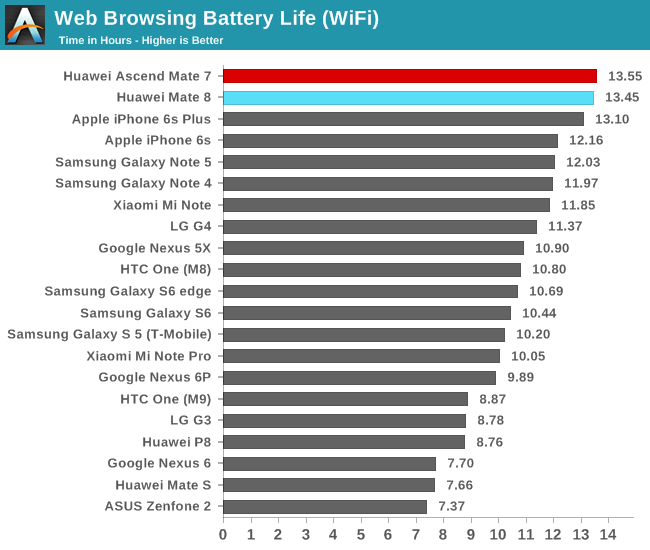
Starting off with our WiFi web-browsing test we see the Mate 8 just get short of 13.5h of battery life. The interesting comparison is here to last year’s Mate 7 as it seems the actually last just as much. This may point out that the screen efficiency measured in our display power testing was maybe correct and the Mate 8 is less efficient. Another aspect is that the Mate 8’s overall platform power consumption hasn’t seen much improvement and thus still represents a large barrier for battery life.
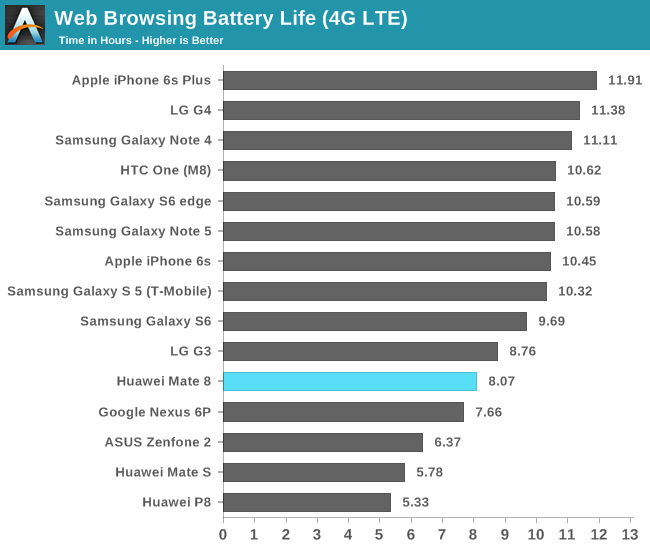
On the 4G LTE test we see that the Mate 8 loses out its advantage over the competition. Again I’m testing under rather mediocre signal conditions so it’s not a valid apples-to-apples comparison to devices reviewed by Joshua or Brandon, however when comparing it against for example such as the Nexus 6P which was tested under the same conditions we see that the Mate 8 faces a much larger battery life degradation going from the WiFi to the LTE test. The reason for this can only be that the Kirin 950’s modem and RF back-end just aren’t as efficient as Qualcomm or even Samsung’s.
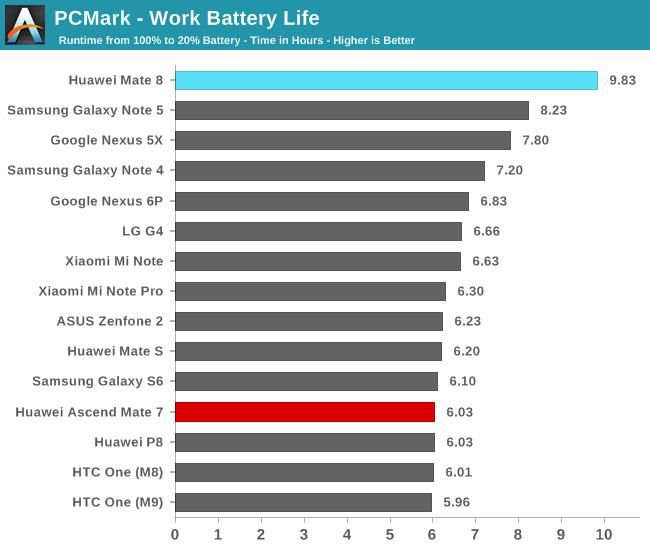
While the web-browsing tests didn’t represent a large improvement for the Mate 8, we see PCMark put the phablet as the current undisputed leader among high-performance devices. Here the difference to the Mate 7 is almost 4 hours, or around a 65% increase in battery life. The increase is most certainly linked to the new SoC’s power efficiency.
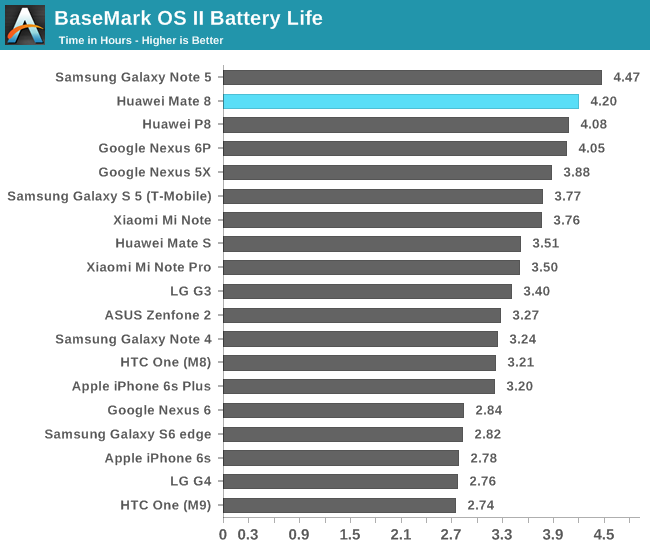
BaseMark OS II’s battery test is more of a maximum load type test that depends on the allowed maximum TDP of the phone. With a 15.2Wh battery and a runtime of 4.2h we see an average consumption of 3.6W, roughly the same amount of power that I saw that the device was able to sustain in our CPU thermal test.

Finally the GFXBench battery test shows that the Mate 8 doesn’t show very good battery life but this is a two-edged sword. As we’ve seen in the GPU section the SoC hardly throttles under heavy GPU load and thus retains its maximum performance for the duration of the test. Considering that the Mate 7 slowed throttled down to 9-10fps and the Mate 8 does not go under 40fps, it still shows that the Mate 8 is twice as efficient as the Mate 7 even though overall battery life is almost twice as short.
At 200 nits the Mate 8 averages an idle power consumption of 989mW and we saw that system load power for the T-Rex test is 3.64W. 3 hours battery runtime averages 5W of power, near the 4.6W we theorized. The small difference may be due to the overhead of actually running the on-screen test and thus also not able to show the DDIC’s savings thanks to PSR due to continuously changing screen content.
Overall I’ve been extremely impressed by the Mate 8’s battery life. In everyday usage this is the longest-lasting device I’ve had the opportunity to use. The Kirin 950’s efficiency is outstanding and is truly able to earn its place among the top for this generation. It seems the Mate 8’s limiting factors are related to the screen and general platform base power consumption, something that Huawei may be able to improve in future devices and thus get even better value out of the Kirin 950.
All being said, if you’re looking for a long-lasting device, you can’t go wrong with the Mate 8.
Charge Time
The Mate 8 advertises fast charging out of the box so that even considering it having a large 4000mAh battery, it should still be fast to fill up when in need. The stock charger is a 9V/2A (18W) unit. I’m not sure if the charging enumeration protocol is based on Quick Charge or Adaptive Fast Charging, but it was able to enable fast-charging on Samsung phones while the Mate 8 didn’t fast-charge on Samsung’s charger, meaning the Huawei charger is likely a Quick Charge unit and the Mate 8’s PMIC and voltage negotiation IC seems to only accept Quick Charge.
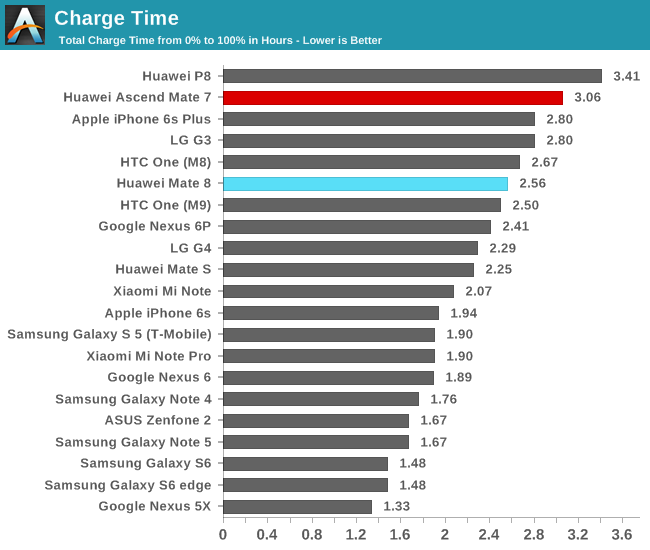
As we see in the charge graph, the Mate 8’s battery cell gets charged at up to 11.5W during the fast-charging phase, being able to reach 80% in 68 minutes around little under 40% charge for each half hour of charging. The last 20% takes up to another 70 minutes as the device switches over to trickle-charging.
While the Mate 8 ends up with total charge time of 2.56 hours, what counts is that the initial 80% of battery capacity can be charged very fast so the Mate 8 is no slouch in this metric.


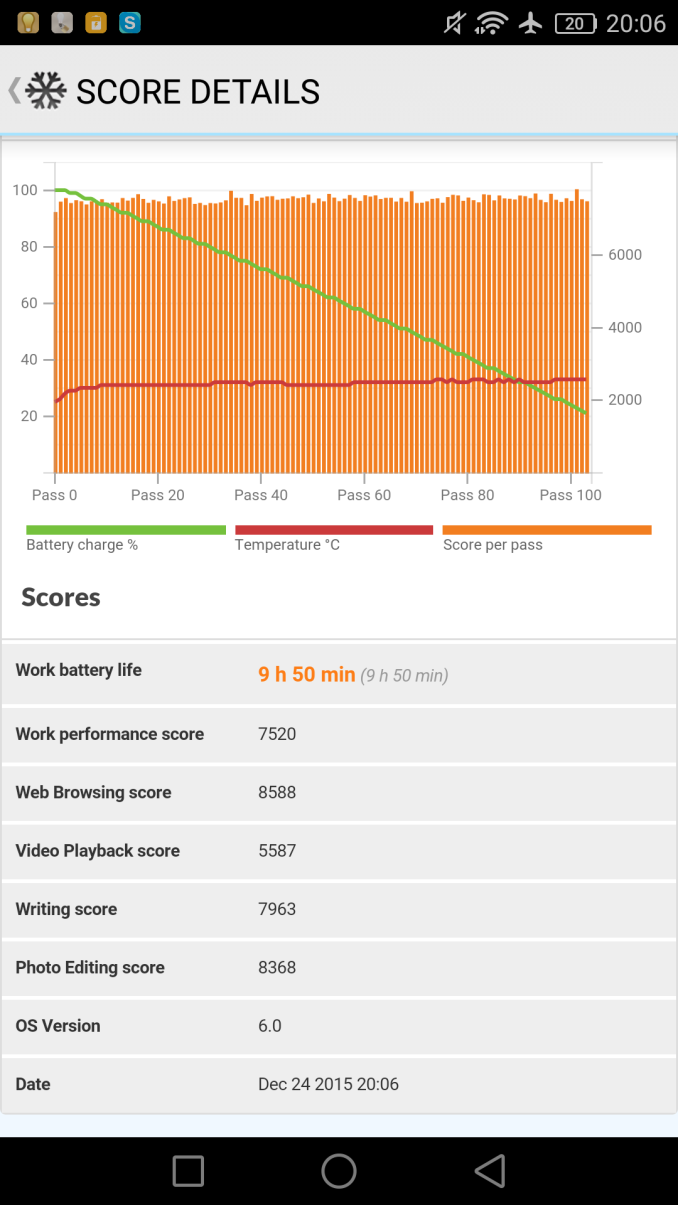
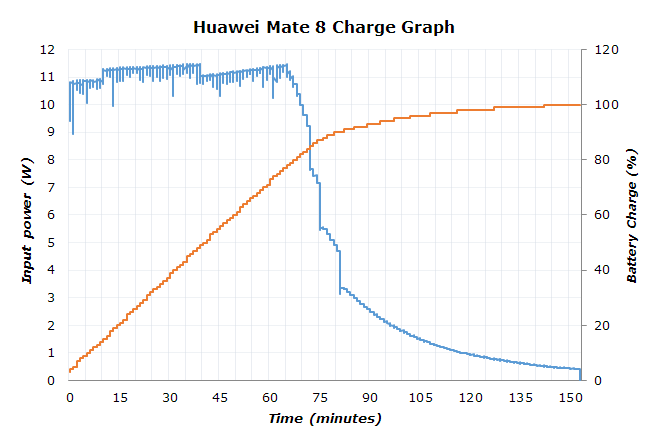








116 Comments
View All Comments
s.yu - Saturday, January 16, 2016 - link
Which will soon become among the slowest of all flagship CPUs. Please, it's one generation above Exynos 7420 (courtesy of ARM) and still doesn't beat it in all aspects.MrSpadge - Tuesday, January 5, 2016 - link
I don't think it makes any sense yet to name "phones" and "high end games" in the same sentence. (still doing it right now)beachletter - Tuesday, January 12, 2016 - link
The mate 8 achieved similar if not better sustained framerates than the Exynos 7420 in demanding games like nba 2k15/2k16. And that is when the 7420 is also running on 1080p, not 2k (Meizu Pro 5).I'd say GPU on the 950 is totally comparable to Exynos 74xx in actual gameplay because it has so little thermal throttling. In fact, it is probably superior to some phones using snapdragon 810, especially after a few minutes of playtime and on 2k screens. I know because I have a Oneplus 2 which plays like shit after 10-15 minutes game time.
This GPU won't compete with 2016 flagship SoCs, but it can easily match the high end chips currently available in actual usage. The graphics benchmark really don't tell you the whole story.
Lolimaster - Tuesday, January 5, 2016 - link
It seems only Apple, Samsung and maybe Xiaomi cares about display accuracy which is better than focusing on gizmos.5th element - Tuesday, January 5, 2016 - link
Google's devices arent half bad, but I agree with you display accuracy should be of primary concern and I, for the life of me, have no idea why it isn't an this extends right across the board to LCD TVs and monitors.ChronoReverse - Tuesday, January 5, 2016 - link
The reason is because more people prefer the overly saturated colours. The most common comment I get when people look at my previous phones where the colours were set to as accurate as possible for that model is "why does it look washed out?".This is why a screen capable of colour accuracy like the Nexus 6P ends up with a saturated default setting.
s.yu - Saturday, January 16, 2016 - link
That's why Samsung's approach with multiple screen modes makes so much sense. Most will leave it on Adaptive, those who care will change it to Basic or AMOLED Photo. Those watching really badly compressed videos could use AMOLED Cinema.s.yu - Saturday, January 16, 2016 - link
One up that!NZtechfreak - Tuesday, January 5, 2016 - link
I've had one of these for nearly three weeks, a 4gb/64gb one (coming from Note 4 and Nexus 6P previously). This review aligns with my experience. Battery life is easily the best I've had, in the same use it is basically doubling what I had with the Note 4 and 6P. Battery life is fairly high on my priority list and this device is a breath of fresh air in this regard. I had noticed the camera issues, but hadn't picked the reason until Andreilux informed me a few days ago. I'm on a newer B129SP02 firmware, which somewhat ameliorates the issue but not as successfully as it needs to. I think this should be able to be resolved in firmware though, so hopefully will see more of the sensors potential in upcoming updates (I've had three firmware updates so far, so certainly they are moving at a reasonable pace to address issues thusfar). Can update as more firmwares come in if people are interested. Regards the screen my subjective experience matches the review. Coming from the Note 4 in basic screen mode and the 6P in sRGB mode, the garish colours are a bit of an eyesore. Not sure if you mentioned it, but the screen is fairly reflective too, so despite a reasonable brightness sunlight viewing is mildly irritating at times. Blacks for a non-AMOLED screen are sufficient for me, white on warmest colour temp also good enough for me. Overall though the panels performance is acceptable for me. The last firmware update changelog mentioned changes to the colour temp adjustment, but I'm not perceiving a difference. I hope they can refine colour temp adjustment further with firmware updates. Again, not sure if I missed it, but the speaker performance here is really enjoyable - best bass I have heard from a smartphone till now. Speaker performace gets noticeably stressed as you approach 70%+ of the volume range, but volume is plentiful enough beneath that to not give me cause for concern. Pleased with your GPU write-up, a balanced viewpoint (it matches my own, so I suppose I would say that). While GPU performance is not wonderful in raw terms, it exceeds most devices this year for native resolution workloads on account of the 1080p screen. Throttling behaviour is particularly pleasing, since I do mostly emulator gaming on my phone and it's really nice playing the Gamecube's Fire Emblem Path of Radiance at fullspeed here (Dolphin overclock setting at 0.2). Overall I'm well pleased, the camera issue needs resolution, but I use my GH3 for when I really want to take nice shots, so for me it isn't the showstopper that it will be for some on current software.name99 - Tuesday, January 5, 2016 - link
"One characteristic that might be defining for the Kirin 950 is that it still uses a CCI-400 fabric"Might I suggest as a future article one that clarifies what the relationship is between all these ARM terms. We have AMBA, CHI, ACE, CCI and probably a few more I've forgotten. They all seem to have something to do with coherency between different "ARM ecosystem" cells, but what exactly, and how are they all related?